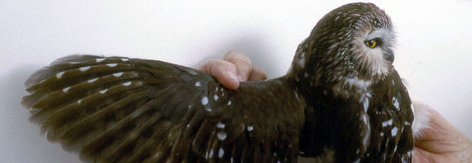The Wrack
The Wrack is the Wells Reserve blog, our collective logbook on the web.
The Wrack is the Wells Reserve blog, our collective logbook on the web.
Bird bander June Ficker recalls how she got started netting saw-whet owls, shares some details about the birds she has banded, and explains a few precautions taken during the autumn saw-whet season…

In 1994, Joan Junker and I attended the Association of Field Ornithologists' meeting in New York All papers presented were on various species of owls, but David Brinker's Northern Saw-whet Owl talk sent my antennae into action. David's summation of the saw-whet's habitat preferences matched the description of habitats at the reserve — plus Nancy McReel had given me a road-killed saw-whet found near the entrance of the nearby Rachel Carson refuge headquarters so I knew they passed through the area.
After consulting with David, who said "Go for it, June," we opened six 12-meter
mist nets the night of October 19, 1994. We played a recording of the saw-whet's call to attract migrating owls and waited.As we checked the first two nets, my helpers and I must have removed a hundred leaves, but my heart began to race as I looked at net #3. There was something unusual about a leaf clump near the bottom trammel. Oh, yes, it was not leaves — it was a saw-whet owl! Wow!
That year we managed to entice another 16 saw-whets before we closed down for the season in early November. Now, after 20 years of saw-whet monitoring, we have captured well over 400.
We have caught four saw-whets banded at another station. Our first "foreign recovery," in 1996, was banded at Manomet, Massachusetts. The others were from Falmouth and Vinalhaven, Maine. Ten saw-whets banded at the Wells Reserve have been recaptured in nets in Massachusetts, Connecticut, New York, New Jersey, Pennsylvania, and Maryland. The Maryland bird was caught in one of David Brinker's nets!
Factors Affecting Saw-whet Owl Banding
Whether we open the nets on a given night depends on weather. If it's too windy, forget it. These little critters get buffeted by the wind and will not migrate on blustery nights. Naturally, we do not operate in the rain.
Another big issue is a full moon, which makes migrating saw-whet owls visible to predators. We have seen three deaths of saw-whet owls in our nets caused by barred and great horned owls. These were so upsetting, I was going to stop the project. When I called Trevor-Lloyd Evans, my banding mentor and trainer at Manomet, he said "Shut down the nets and play no sound for three or four nights. Frequently these predators are young barred and great horned owls looking for a good spot to winter. Playing the tape is an open invitation for banquet." Trevor's instructions have been successful and we continue to follow them.
Since 2000, we have used Dave Brinker's guidelines, approved by the Bird Banding Laboratory, to determine whether a saw-whet is male or female. In general, this is through a combination of weight and wing measurements. We also determine the age of captured owls by using an excellent set of illustrations shared through Project Owlnet.
Even though the reserve is not on what one would consider a migratory flyway for Northern Saw-whet Owls, every one that comes to our nets is frosting on the cake!